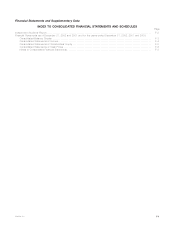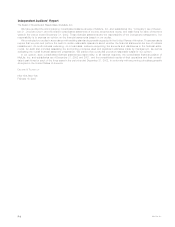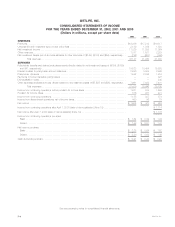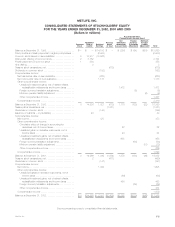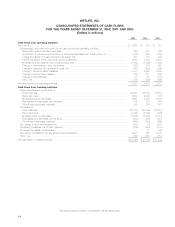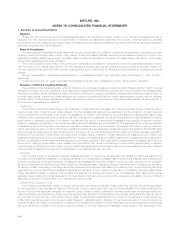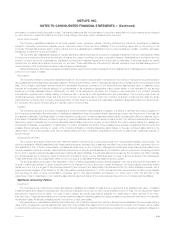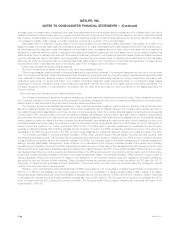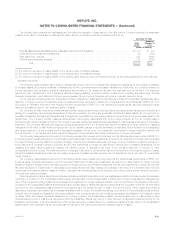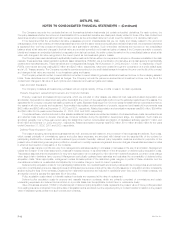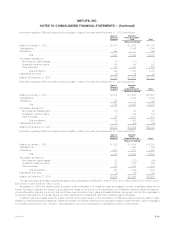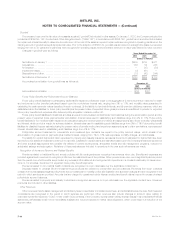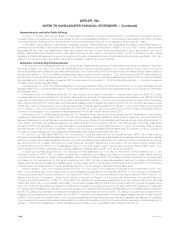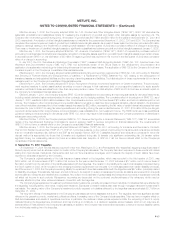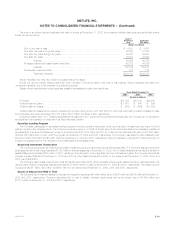MetLife 2002 Annual Report Download - page 55
Download and view the complete annual report
Please find page 55 of the 2002 MetLife annual report below. You can navigate through the pages in the report by either clicking on the pages listed below, or by using the keyword search tool below to find specific information within the annual report.
METLIFE, INC.
NOTES TO CONSOLIDATED FINANCIAL STATEMENTS — (Continued)
The following table presents the total assets and the maximum exposure to loss relating to the VIEs that the Company believes it is reasonably
possible it will need to consolidate or disclose information about in accordance with the provisions of FIN 46 at:
December 31, 2002
Maximum
Total Exposure to
Assets Loss
(Dollars in millions)
Financial asset-backed securitizations and collateralized debt and bond obligations********************************* $1,719 $ 9(1)
Other structured investment transactions*************************************************************** 89 38(2)
Real estate joint ventures**************************************************************************** 443 196(3)
Other limited partnership interests ******************************************************************** 872 167(3)
Total ************************************************************************************* $3,123 $410
(1) The maximum exposure to loss is based on the carrying value of retained interests.
(2) The maximum exposure to loss is based on the carrying value of beneficial interests.
(3) The maximum exposure to loss is based on the carrying value plus unfunded commitments reduced by amounts guaranteed by other partners.
Derivative Instruments
The Company uses derivative instruments to manage risk through one of four principal risk management strategies: (i) the hedging of liabilities,
(ii) invested assets, (iii) portfolios of assets or liabilities and (iv) firm commitments and forecasted transactions. Additionally, the Company enters into
income generation and replication derivative transactions as permitted by its derivatives use plan that was approved by the New York Insurance
Department (the ‘‘Department’’). The Company’s derivative hedging strategy employs a variety of instruments, including financial futures, financial
forwards, interest rate, credit default and foreign currency swaps, foreign currency forwards, and options, including caps and floors.
On the date the Company enters into a derivative contract, management designates the derivative as a hedge of the identified exposure (fair value,
cash flow or foreign currency). If a derivative does not qualify as a hedge, according to Statement of Financial Accounting Standards (‘‘SFAS’’) No. 133,
Accounting for Derivative Instruments and Hedging Activities, as amended (‘‘SFAS 133’’), the derivative is recorded at fair value and changes in its fair
value are generally reported in net investment gains or losses.
The Company formally documents all relationships between hedging instruments and hedged items, as well as its risk management objective and
strategy for undertaking various hedge transactions. In this documentation, the Company specifically identifies the asset, liability, firm commitment, or
forecasted transaction that has been designated as a hedged item and states how the hedging instrument is expected to hedge the risks related to the
hedged item. The Company formally measures effectiveness of its hedging relationships both at the hedge inception and on an ongoing basis in
accordance with its risk management policy. The Company generally determines hedge effectiveness based on total changes in fair value of a derivative
instrument. The Company discontinues hedge accounting prospectively when: (i) it is determined that the derivative is no longer effective in offsetting
changes in the fair value or cash flows of a hedged item, (ii) the derivative expires or is sold, terminated, or exercised, (iii) the derivative is de-designated
as a hedge instrument, (iv) it is probable that the forecasted transaction will not occur, (v) a hedged firm commitment no longer meets the definition of a
firm commitment, or (vi) management determines that designation of the derivative as a hedge instrument is no longer appropriate.
The Company designates and accounts for the following as cash flow hedges, when they have met the effectiveness requirements of SFAS 133:
(i) various types of interest rate swaps to convert floating rate investments to fixed rate investments, (ii) receive U.S. dollar fixed on foreign currency swaps
to hedge the foreign currency cash flow exposure of foreign currency denominated investments, (iii) foreign currency forwards to hedge the exposure of
future payments or receipts in foreign currencies, and (iv) other instruments to hedge the cash flows of various other forecasted transactions. For all
qualifying and highly effective cash flow hedges, the effective portion of changes in fair value of the derivative instrument is reported in other
comprehensive income or loss. The ineffective portion of changes in fair value of the derivative instrument is reported in net investment gains or losses.
Hedged forecasted transactions, other than the receipt or payment of variable interest payments, are not expected to occur more than 12 months after
hedge inception.
The Company designates and accounts for the following as fair value hedges when they have met the effectiveness requirements of SFAS 133:
(i) various types of interest rate swaps to convert fixed rate investments to floating rate investments, (ii) receive U.S. dollar floating on foreign currency
swaps to hedge the foreign currency fair value exposure of foreign currency denominated investments, and (iii) other instruments to hedge various other
fair value exposures of investments. For all qualifying and highly effective fair value hedges, the changes in fair value of the derivative instrument are
reported as net investment gains or losses. In addition, changes in fair value attributable to the hedged portion of the underlying instrument are reported in
net investment gains and losses.
When hedge accounting is discontinued because it is determined that the derivative no longer qualifies as an effective fair value hedge, the derivative
continues to be carried on the consolidated balance sheet at its fair value, but the hedged asset or liability will no longer be adjusted for changes in fair
value. When hedge accounting is discontinued because the hedged item no longer meets the definition of a firm commitment, the derivative continues to
be carried on the consolidated balance sheet at its fair value, and any asset or liability that was recorded pursuant to recognition of the firm commitment is
removed from the consolidated balance sheet and recognized as a net investment gain or loss in the current period. When hedge accounting is
discontinued because it is probable that a forecasted transaction will not occur, the derivative continues to be carried on the consolidated balance sheet
at its fair value, and gains and losses that were accumulated in other comprehensive income or loss are recognized immediately in net investment gains
or losses. When the hedged forecasted transaction is no longer probable, but is reasonably possible, the accumulated gain or loss remains in other
comprehensive income or loss and is recognized when the transaction affects net income or loss; however, prospective hedge accounting for the
transaction is terminated. In all other situations in which hedge accounting is discontinued, the derivative is carried at its fair value on the consolidated
balance sheet, with changes in its fair value generally recognized in the current period as net investment gains or losses.
MetLife, Inc. F-11


